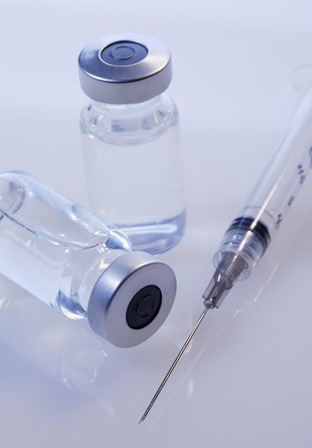User login
NEW ORLEANS – While vaccinations are certainly a health benefit to pediatric patients, they may be a financial risk for pediatricians, according to Dr. Herschel R. Lessin.
"Vaccines are expensive, complicated, and require a lot of time-consuming communication with parents. If they’re not managed correctly, they can bankrupt your business," he said at the annual meeting of the American Academy of Pediatrics. "Vaccines are the second-largest budget item in your business, after payroll, and can tie up enormous amounts of capital. You need to be smart about how you use them and how you buy them."
It’s hard to judge how much vaccines really cost a practice, said Dr. Lessin, a pediatrician in private practice in Poughkeepsie, N.Y. In addition to the actual cost of the product, the equation has to include the cost of time spent on counseling about vaccines’ risks and benefits, defusing the popular mythology attached to them, and taking calls about reactions. Add to that the equipment necessary to administer and store them, and you have a situation that may very well be costing more than it brings in.
"It’s a question of opportunity cost," he said. "Ask yourself, ‘What other things could I have done with that money?’ "
Purchasing is the biggest up-front outlay. "The absolute worst way to buy these is to purchase them on your own from the drug company. It’s a little bit more economical if you’re part of a practice group and you share the cost with your colleagues. Or you can team up with other practices in your area and create a group purchase organization [GPO]."
But this kind of business relationship works only if the group provides enough financial incentive to offset the headaches of joining.
GPOs combine buying power from multiple members to get better prices on vaccine. The organizations deal directly with vaccine manufacturers to negotiate what usually turn out to be the best prices. Another benefit is that orders are placed individually. Practices can order just what they need and not be forced to order a large volume to get a discount.
But they almost always come with rules designed to keep a practice connected with the group, and with the manufacturers who participate. "All GPOs have rules you must abide by and products you must use to get the savings. If you see a good price on a vaccine and switch to it, you might be financially punished" for buying it, by being forced to pay list price on the vaccine you do order through the group, he said.
Another option is to collaborate with other practices in the community to negotiate deals directly with the manufacturer. Dr. Lessin said his practice did just that a few years ago. Although collaborating with a competitor was initially uncomfortable, it actually became a first step toward improving relations between the two businesses.
"We found out they weren’t quite the ogre that we thought they were," he said.
Cost concerns don’t evaporate even after the vaccine is delivered and safely tucked in the refrigerator. That’s when some of the thorniest issues arise, he said. Vaccines don’t administer themselves. They require equipment, providers, and communication that are specialized.
"The real cost of vaccines is much, much more than the price," Dr. Lessin said. The hidden costs include equipment, syringes, waste handling, and simple things such as gloves, swabs, and Band-Aid strips. Other less-tangible costs are time spent preparing the vaccine, counseling the parents, and documenting the procedure.
The usual per-patient profit for an office visit ranges from 30% to 50%, but drops off sharply when vaccines are figured into the mix, Dr. Lessin said. "If it’s your second-biggest expense, you better be making a profit of it. Vaccine is a product and we are selling product." Some practices have decided to increase their fees in order to cover the cost of vaccine administration.
"You deserve to make a profit margin on administrative costs," he said.
The American Academy of Pediatrics offers several free resources on building a successful vaccine practice model.
Dr. Lessin disclosed that he is on the speakers board of GlaxoSmithKline and the advisory boards of Merck, Novartis, and Pfizer. He is also a senior consultant for the Verden Group, a practice management company.
NEW ORLEANS – While vaccinations are certainly a health benefit to pediatric patients, they may be a financial risk for pediatricians, according to Dr. Herschel R. Lessin.
"Vaccines are expensive, complicated, and require a lot of time-consuming communication with parents. If they’re not managed correctly, they can bankrupt your business," he said at the annual meeting of the American Academy of Pediatrics. "Vaccines are the second-largest budget item in your business, after payroll, and can tie up enormous amounts of capital. You need to be smart about how you use them and how you buy them."
It’s hard to judge how much vaccines really cost a practice, said Dr. Lessin, a pediatrician in private practice in Poughkeepsie, N.Y. In addition to the actual cost of the product, the equation has to include the cost of time spent on counseling about vaccines’ risks and benefits, defusing the popular mythology attached to them, and taking calls about reactions. Add to that the equipment necessary to administer and store them, and you have a situation that may very well be costing more than it brings in.
"It’s a question of opportunity cost," he said. "Ask yourself, ‘What other things could I have done with that money?’ "
Purchasing is the biggest up-front outlay. "The absolute worst way to buy these is to purchase them on your own from the drug company. It’s a little bit more economical if you’re part of a practice group and you share the cost with your colleagues. Or you can team up with other practices in your area and create a group purchase organization [GPO]."
But this kind of business relationship works only if the group provides enough financial incentive to offset the headaches of joining.
GPOs combine buying power from multiple members to get better prices on vaccine. The organizations deal directly with vaccine manufacturers to negotiate what usually turn out to be the best prices. Another benefit is that orders are placed individually. Practices can order just what they need and not be forced to order a large volume to get a discount.
But they almost always come with rules designed to keep a practice connected with the group, and with the manufacturers who participate. "All GPOs have rules you must abide by and products you must use to get the savings. If you see a good price on a vaccine and switch to it, you might be financially punished" for buying it, by being forced to pay list price on the vaccine you do order through the group, he said.
Another option is to collaborate with other practices in the community to negotiate deals directly with the manufacturer. Dr. Lessin said his practice did just that a few years ago. Although collaborating with a competitor was initially uncomfortable, it actually became a first step toward improving relations between the two businesses.
"We found out they weren’t quite the ogre that we thought they were," he said.
Cost concerns don’t evaporate even after the vaccine is delivered and safely tucked in the refrigerator. That’s when some of the thorniest issues arise, he said. Vaccines don’t administer themselves. They require equipment, providers, and communication that are specialized.
"The real cost of vaccines is much, much more than the price," Dr. Lessin said. The hidden costs include equipment, syringes, waste handling, and simple things such as gloves, swabs, and Band-Aid strips. Other less-tangible costs are time spent preparing the vaccine, counseling the parents, and documenting the procedure.
The usual per-patient profit for an office visit ranges from 30% to 50%, but drops off sharply when vaccines are figured into the mix, Dr. Lessin said. "If it’s your second-biggest expense, you better be making a profit of it. Vaccine is a product and we are selling product." Some practices have decided to increase their fees in order to cover the cost of vaccine administration.
"You deserve to make a profit margin on administrative costs," he said.
The American Academy of Pediatrics offers several free resources on building a successful vaccine practice model.
Dr. Lessin disclosed that he is on the speakers board of GlaxoSmithKline and the advisory boards of Merck, Novartis, and Pfizer. He is also a senior consultant for the Verden Group, a practice management company.
NEW ORLEANS – While vaccinations are certainly a health benefit to pediatric patients, they may be a financial risk for pediatricians, according to Dr. Herschel R. Lessin.
"Vaccines are expensive, complicated, and require a lot of time-consuming communication with parents. If they’re not managed correctly, they can bankrupt your business," he said at the annual meeting of the American Academy of Pediatrics. "Vaccines are the second-largest budget item in your business, after payroll, and can tie up enormous amounts of capital. You need to be smart about how you use them and how you buy them."
It’s hard to judge how much vaccines really cost a practice, said Dr. Lessin, a pediatrician in private practice in Poughkeepsie, N.Y. In addition to the actual cost of the product, the equation has to include the cost of time spent on counseling about vaccines’ risks and benefits, defusing the popular mythology attached to them, and taking calls about reactions. Add to that the equipment necessary to administer and store them, and you have a situation that may very well be costing more than it brings in.
"It’s a question of opportunity cost," he said. "Ask yourself, ‘What other things could I have done with that money?’ "
Purchasing is the biggest up-front outlay. "The absolute worst way to buy these is to purchase them on your own from the drug company. It’s a little bit more economical if you’re part of a practice group and you share the cost with your colleagues. Or you can team up with other practices in your area and create a group purchase organization [GPO]."
But this kind of business relationship works only if the group provides enough financial incentive to offset the headaches of joining.
GPOs combine buying power from multiple members to get better prices on vaccine. The organizations deal directly with vaccine manufacturers to negotiate what usually turn out to be the best prices. Another benefit is that orders are placed individually. Practices can order just what they need and not be forced to order a large volume to get a discount.
But they almost always come with rules designed to keep a practice connected with the group, and with the manufacturers who participate. "All GPOs have rules you must abide by and products you must use to get the savings. If you see a good price on a vaccine and switch to it, you might be financially punished" for buying it, by being forced to pay list price on the vaccine you do order through the group, he said.
Another option is to collaborate with other practices in the community to negotiate deals directly with the manufacturer. Dr. Lessin said his practice did just that a few years ago. Although collaborating with a competitor was initially uncomfortable, it actually became a first step toward improving relations between the two businesses.
"We found out they weren’t quite the ogre that we thought they were," he said.
Cost concerns don’t evaporate even after the vaccine is delivered and safely tucked in the refrigerator. That’s when some of the thorniest issues arise, he said. Vaccines don’t administer themselves. They require equipment, providers, and communication that are specialized.
"The real cost of vaccines is much, much more than the price," Dr. Lessin said. The hidden costs include equipment, syringes, waste handling, and simple things such as gloves, swabs, and Band-Aid strips. Other less-tangible costs are time spent preparing the vaccine, counseling the parents, and documenting the procedure.
The usual per-patient profit for an office visit ranges from 30% to 50%, but drops off sharply when vaccines are figured into the mix, Dr. Lessin said. "If it’s your second-biggest expense, you better be making a profit of it. Vaccine is a product and we are selling product." Some practices have decided to increase their fees in order to cover the cost of vaccine administration.
"You deserve to make a profit margin on administrative costs," he said.
The American Academy of Pediatrics offers several free resources on building a successful vaccine practice model.
Dr. Lessin disclosed that he is on the speakers board of GlaxoSmithKline and the advisory boards of Merck, Novartis, and Pfizer. He is also a senior consultant for the Verden Group, a practice management company.
EXPERT ANALYSIS FROM THE ANNUAL MEETING OF THE AMERICAN ACADEMY OF PEDIATRICS


